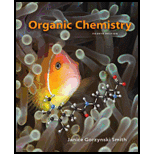
Concept explainers
(a)
Interpretation: The two possible resonance structures for the radical formed by the homolysis of indicated bond in propene are to be drawn.
Concept introduction: In
Resonance is the delocalisation of
(b)
Interpretation: The half-headed curved arrows are to be used to illustrate the conversion of one resonance structure to other.
Concept introduction: Curved arrows aid in determining the movement and flow of electrons in the reaction. The electrons that take part in the
Half headed arrows are used to show the flow of single electrons, while the full headed arrow shows the movement of electron pairs.
(c)
Interpretation: The structure of the resonance hybrid is to be drawn.
Concept introduction: Resonance is the delocalisation of
Want to see the full answer?
Check out a sample textbook solution
Chapter 6 Solutions
Organic Chemistry
- When the conjugate acid of aniline, C6H5NH3+, reacts with the acetate ion, the following reaction takes place: C6H5NH3+(aq)+CH3COO(aq)C6H5NH2(aq)+CH3COOH(aq) If Kafor C6H5NH3+ is 1.35105 and Kafor CH3COOH is 1.86105 , what is K for the reaction?arrow_forwardCyclopentene reacted with bromine, Br 2, gives what product?arrow_forwardDraw a chiral alkene with the formula C6H12.arrow_forward
- write the structure formulas of alkanes with molecular formula C6H14, which with chlorine give: a) three monochlorinated isomers? b) five monochlorinated isomers c) only two monochlorinated isomersarrow_forwardDraw and name two non-alkenes with the formula C4H8arrow_forwardDraw all aldehydes and ketones with the formula C₅H₁₀Oarrow_forward
- Give the molecular formula of a hydrocarbon containingsix carbon atoms that is (a) a cyclic alkane, (b) a cyclicalkene, (c) a linear alkyne, (d) an aromatic hydrocarbon.arrow_forwardDraw the structures of all monobromo derivatives of pentane, C5H11Br, which contain a 4-carbon chain.arrow_forwardDraw an isomer of C5H10O that contains an alkene or alkynearrow_forward
 Chemistry: Principles and PracticeChemistryISBN:9780534420123Author:Daniel L. Reger, Scott R. Goode, David W. Ball, Edward MercerPublisher:Cengage Learning
Chemistry: Principles and PracticeChemistryISBN:9780534420123Author:Daniel L. Reger, Scott R. Goode, David W. Ball, Edward MercerPublisher:Cengage Learning Chemistry: Principles and ReactionsChemistryISBN:9781305079373Author:William L. Masterton, Cecile N. HurleyPublisher:Cengage Learning
Chemistry: Principles and ReactionsChemistryISBN:9781305079373Author:William L. Masterton, Cecile N. HurleyPublisher:Cengage Learning Chemistry by OpenStax (2015-05-04)ChemistryISBN:9781938168390Author:Klaus Theopold, Richard H Langley, Paul Flowers, William R. Robinson, Mark BlaserPublisher:OpenStax
Chemistry by OpenStax (2015-05-04)ChemistryISBN:9781938168390Author:Klaus Theopold, Richard H Langley, Paul Flowers, William R. Robinson, Mark BlaserPublisher:OpenStax


